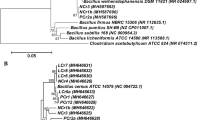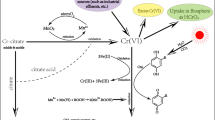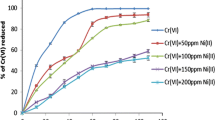Abstract
A chromium-reducing strain isolated from activated sludge and subsequently identified as Clostridium sp. SS1 by a biomolecular method was studied for its resistance to toxic hexavalent chromium [Cr(VI)] and its ability to reduce Cr(IV). The strain was found to tolerate concentrations of Cr(VI) up to 50 mg/l; however, cell growth was severely affected by the presence of Cr(VI), especially at concentrations of more than 20 mg/l. Clostridium sp. SS1 also effectively reduced toxic Cr(VI) into the comparatively less toxic trivalent form. The optimum pH value for Cr(VI) reduction was 7.0, and the cells reduced Cr(VI) more efficiently at 30°C than at 20 and 40°C. Within the same incubation time, higher amounts of Cr(VI) were reduced at higher initial Cr(VI) concentrations (range 5–40 mg/l). Clostridium sp. SS1 had a higher volumetric [0.82 mg Cr(VI)/l/h] and greater capacity [72 mg Cr(VI)/g biomass] to reduce Cr(VI) at higher initial Cr(VI) concentrations (40 mg/l), suggesting that this strain could be potentially useful for the detoxification of Cr(VI) polluted sites.







Similar content being viewed by others
References
Ackerley DF, Gonzalez CF, Park CH, Blake R II, Keyhan M, Martin A (2004) Chromate reducing properties of soluble flavoproteins from Pseudomonas putida and E. Coli. Appl Environ Microbiol 70:873–882
Atkinson B, Mavituna F (1983) Biochemical engineering and biotechnology handbook. Nature Press, London
Barbooti MM, Ageena NA, Tooma MA (2008) Removal of chromium. From electroplating wastewater by simple chemical treatment and ion exchange. Eng Technol J 26:11
Bopp LH, Henry LE (1998) Chromate resistance and reduction in Pseudomonas fluorescens strain LB300. Arch Microbiol 150:426–431
Cheung KH, Gu JD (2005) Chromate reduction by bacillus megaterium TKW3 isolated from marine sediments. WJ Microbiol Biotechnol 21:213–219
Camargo FAO, Okeke BC, Bento FM, Frankenberger WT (2005) Diversity of chromium-resistant bacteria isolated from soils contaminated with dichromate. Appl Soil Ecol 29:193–202
Deleo PC, Henry LE (1994) Reduction of hexavalent chromium by Pseudomonas fluorecens LB300 in batch and continuous cultures. Appl Microbiol Biotechnol 40:756–759
Faisal M, Hasnain S (2004) Comparative study of chromium uptake and reduction in industrial effluent by Ochrobactrum intermedium and Brevibacterium sp. Biotechnol Lett 26:1623–1628
Gupta VK, Rastogi A (2008) Sorption and desorption study of chromium (VI) from nonviable Cyanobacterium Nostoc muscorum biomass. J Hazard Mater 154:347–354
Sharma K (2002) Microbial Cr (VI) reduction: role of electron donors, acceptors, and mechanisms, with special emphasis on Clostridium spp. PhD thesis. University of Florida
Liyuan C, Huang SH, Yang Z, Peng B, Huang Y, Chen Y (2009) Cr (VI) remediation by indigenous bacteria in soils contaminated by chromium-containing slag. J Hazard Mater 167:516–522
Liu YG, Xu WH, Zeng GM, Li X, GAO H (2006) Cr (VI) reduction by Bacillus sp. isolated from chromium landfill. Proc Biochem 41:1981–1986
Morales-Barrena L, Jimenez FMC, Moreno AO, Urbina EC (2008) Isolation, identification and characterization of a Hypocrea tawa strain with high Cr (VI) reduction potential. Biochem Eng J 40:284–292
Myers CR, Carstens BP, Antholine WE, Myers JM (2000) Chromium (VI) reductase activity is associated with the cytoplasmic membrane of anaerobically grown Shewanella putrefaciens MR-1. J Appl Microbiol 88:98–106
Mishra S, Doble M (2008) Novel chromium tolerant microorganisms: isolation characterization and their biosorption capacity. Ecotoxicol Environ Saf 71:874–879
Middleton SS, Latmani RB, Mackey MR, Ellisman MH, Tebo BM, Criddle CS (2003) Cometabolism of chromium (VI) by Shewanella oneidensis MR-1 produces cell-associated reduced chromium and inhibits growth. Biotechnol Bioeng 83:627–637
Nkhalambayausi-Chirwa EM, Wang YT (2000) Simultaneous chromium (VI) reduction and phenol degradation in an anaerobic consortium of bacteria. Water Res 34:2376–2384
Pal N (1997) Reduction of hexavalent chromium to trivalent chromium by Phanerochaete chrysosporium. In: Alleman BC, Leeson A (eds) In Situ On-Site Bioreclam Symp, vol 1. Batelle Press, Columbus, pp 511-517
Pattanapipitpaisal BPNL, Macaskie LE (2001) Chromate reduction and 16S rRNA identification of bacteria isolated from a Cr (VI)-contaminated site. Appl Microbiol Biotechnol 57:257–261
Pulane EM, Kakonge CM, Nkhalambayausi-Chirwa EM (2008) Chromium (VI) reduction in activated sludge bacteria exposed to high loading: brits culture (South Africa). Water Res 42:4538–4548
Philip L, Iyengar L, Venkobachar C (1998) Cr (VI) reduction by bacillus coagulans isolated from contaminated soils. J Environ Eng 124(12):1165–1170
Shakoori AR, Makhdoom M, Haq RU (2000) Hexavalent chromium reduction by a dichromate- resistant gram-positive bacterium isolated from effluents of tanneries. Appl Microbiol Biotechnol 53:348–351
Stasinakis AS, Thomaidis NS, Mamais D, Lekkas TD (2004) Investigation of chromium (VI) reduction in continuous-flow activated sludge systems. Chemosph 57:1069–1077
Stasinakis AS, Thomaidis NS, Mamais D, Lekkas TD (2003) Effects of chromium (VI) addition on the activated sludge process. Water Res 37:2140–2148
Thacker PR, Shouche Y, Madamwar D (2006) Hexavalent chromium reduction by Providencia sp. Proc Biochem 41:1332–1337
Viamajala S, Peyton BM, Petersen JN (2003) Modeling chromate reduction in Shewanella oneidensis MR-1: development of a novel dual-enzyme kinetic model. Biotechnol Bioeng 83:190–797
Wang YT, Shen H ( 1997) Modelling Cr( VI) reduction by pure bacterial cultures. Water Res 41(4):727–732
Wang YT, Xiao C (1995) Factors affecting hexavalent chromium reduction in pure cultures of bacteria. Water Res 29(11):2467–2474
Yao J, Tian L, Wang YX, Djah A, Wang F, Chen HL, Su CL, Zhuang RS, Zhou Y, Choi MMF, Bramanti E (2008) Microcalorimetric study the toxic effect of hexavalent chromium on microbial activity of Wuhan brown sandy soil: an in vitro approach. Ecotoxicol Environ Saf 69:289–295
Zakaria ZA, Zakaria Z, Surif S, Ahmad WA (2007) Hexavalent chromium reduction by acinetobacter haemolyticus isolated from heavy-metal contaminated wastewater. J Hazard Mater 146:30–38
Acknowledgements
This work was supported by the National High Technology Research and development Program of China (863 Program) (Grant No. 2007AA06Z337), and Chinese Scholarship Council (CSC). We thank Sun Hongli, Zheng Weilin, and our other lab colleagues for their friendly assistance.
Author information
Authors and Affiliations
Corresponding author
Rights and permissions
About this article
Cite this article
Nguema, P.F., Luo, Z. Aerobic chromium(VI) reduction by chromium-resistant bacteria isolated from activated sludge. Ann Microbiol 62, 41–47 (2012). https://doi.org/10.1007/s13213-011-0224-7
Received:
Accepted:
Published:
Issue Date:
DOI: https://doi.org/10.1007/s13213-011-0224-7




